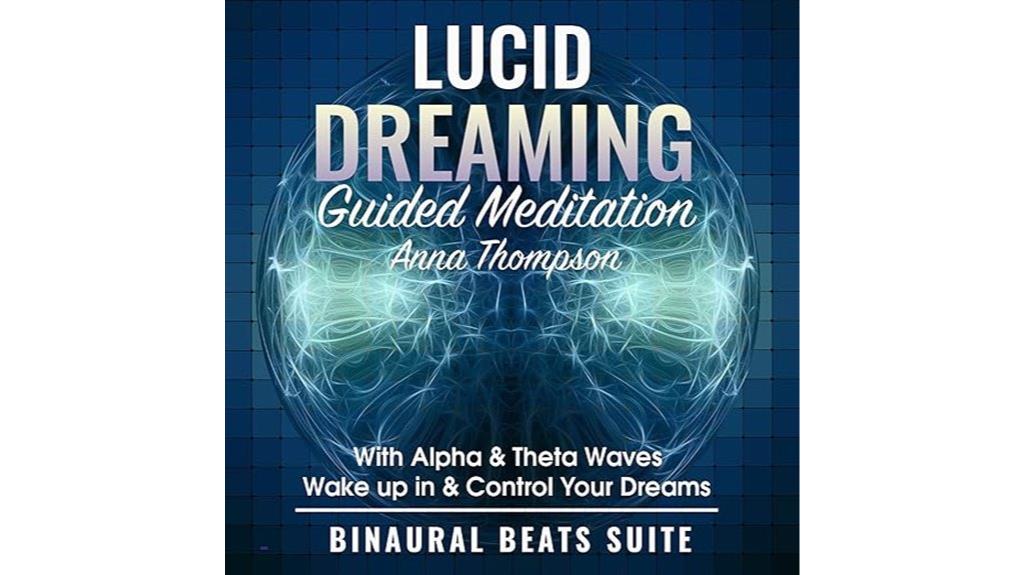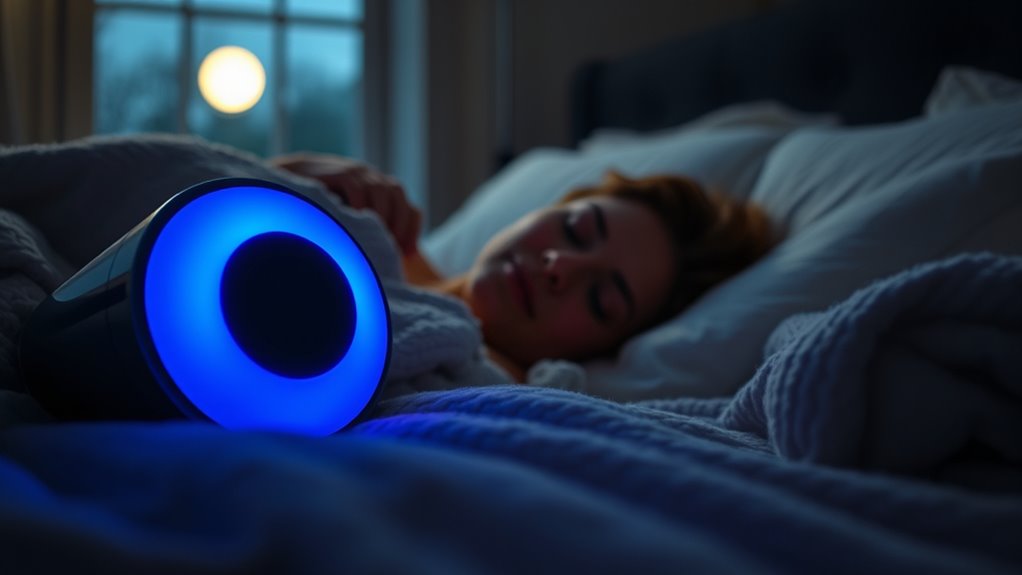Based on expert recommendations, the top binaural beats for lucid dreaming focus on alpha (8-13 Hz) and theta (4-8 Hz) frequencies, which promote deep relaxation and heightened awareness. I suggest choosing high-quality tracks that match your personal preferences and guarantee clear stereo separation for effective entrainment. Adjust volume and session length to suit your comfort, and consider added features like ambient sounds to enhance focus. If you’d like real tips for ideal use, keep exploring how to create the perfect dream-inducing experience.
Key Takeaways
- Binaural beats targeting alpha (8-13 Hz) and theta (4-8 Hz) frequencies are most effective for inducing lucid dreaming.
- Choose high-quality, professionally produced tracks with clear stereo separation to ensure optimal brainwave entrainment.
- Sessions of 30-60 minutes are recommended to deepen relaxation and increase the likelihood of lucid dreams.
- Match binaural beat frequencies to your current brain state for smoother transition into the lucid dreaming phase.
- Incorporate ambient sounds or guided visualizations to enhance receptivity and promote a relaxed, focused mind.
Lucid Dreaming Guided Meditation with Alpha & Theta Waves

If you’re an experienced meditator seeking to deepen your lucid dreaming practice, this guided meditation with alpha and theta waves might be the right fit. With 32 years of meditation experience myself, I find that a calming voice greatly enhances effectiveness. The guided session aims to induce these brainwaves, helping you gain control over your dreams and wake within them. While I appreciate the relaxing tone, I’ve noticed some repetitive phrases across sessions, which can be frustrating. Still, if you’re patient and open to subtle variations, this meditation can support your journey into lucid dreaming. Just be mindful of your preferences to maximize its benefits.
Best For: experienced meditators seeking to enhance their lucid dreaming practice through guided meditation with brainwave induction.
Pros:
- Uses alpha and theta wave induction to facilitate lucid dreaming and dream control
- Calming voice quality enhances relaxation and overall experience
- Suitable for those with extensive meditation background looking to deepen their practice
Cons:
- Contains repetitive phrases across sessions, which may lead to dissatisfaction
- Some users may find the content too similar or predictable over time
- Uncertainty about the refund policy could affect purchase confidence
Factors to Consider When Choosing Audio Binaural Beats for Lucid Dreaming

When selecting binaural beats for lucid dreaming, I consider several key factors to guarantee the best experience. It’s important to match the brainwave frequencies with your goals, check audio quality, and choose sounds that resonate with your personal preferences. Additionally, paying attention to volume, session length, and overall comfort helps maximize the effectiveness of your practice.
Brainwave Frequency Compatibility
Choosing binaural beats that match your natural brainwave frequencies is essential for maximizing the chances of lucid dreaming. When the beats align with your current brainwave state, they help facilitate a smoother progression into the desired dreaming phase. For example, targeting alpha (8-13 Hz) and theta (4-8 Hz) frequencies promotes relaxation and heightened suggestibility, which are key for lucid dreaming. If the frequencies are too far from your natural oscillations, your brain might resist entrainment, leading to discomfort or ineffective results. Personal responsiveness varies, so selecting beats that closely match your existing brainwave patterns can considerably improve your chances. Ensuring compatibility helps your brain transition comfortably into the dream state, making lucid dreaming more attainable and enjoyable.
Audio Quality Standards
High-quality binaural beats rely on clear, crisp audio to effectively entrain brainwaves and promote lucid dreaming. To achieve this, the audio should have minimal background noise or distortion, guaranteeing a smooth listening experience. Consistent sample rates and bit depths help prevent audio artifacts that could disrupt entrainment. Professional production techniques, such as proper stereo separation and balanced frequency ranges, enhance clarity and effectiveness. Seamless looping capabilities are also important, as they prevent abrupt transitions that might distract or break concentration during meditation. Additionally, compatibility across various devices and audio formats guarantees the binaural beats maintain their integrity regardless of how or where you listen. Prioritizing these standards helps maximize the potential benefits for lucid dreaming.
Personal Preference Alignment
Your personal preferences play a crucial role in selecting binaural beats for lucid dreaming, as the right audio should feel comfortable and engaging to you. I’ve found that the tone and delivery style of the voice can considerably influence how effectively I relax and focus. The background sounds or ambient music accompanying the beats should match my taste to enhance my relaxation rather than distract me. I also pay attention to the frequency range—whether alpha or theta waves—that feels most natural and responsive to me. Additionally, I prefer sound layers that aren’t overly complex or overstimulating, ensuring I stay calm and focused. Finally, I consider my usual listening environment and volume preferences, as familiarity and comfort can make a big difference in achieving lucid dreaming.
Volume and Balance Settings
Adjusting the volume and balance of binaural beats is key to creating an ideal listening environment for lucid dreaming. You want the beats to be audible enough to influence your brainwaves but not so loud that they cause discomfort or distortion. Finding the right volume helps you stay relaxed and focused without distraction. Balancing the left and right channels is equally important, as it ensures your brain perceives the intended frequency difference accurately. If the audio is too loud, it might lead to distraction or irritation, reducing effectiveness. Conversely, if it’s too quiet, it may not induce the desired brainwave states. Adjusting these settings based on your personal comfort can optimize your experience, making your lucid dreaming sessions more effective and enjoyable.
Duration and Session Length
Choosing the right duration for listening to binaural beats is essential because it can considerably influence how effectively you enter a lucid dreaming state. Longer sessions, around 30 to 60 minutes, often promote deep relaxation and increase your chances of lucid dreaming, especially with consistent practice. Shorter sessions, about 10 to 15 minutes, can be useful for quick relaxation but may not be as effective for inducing lucid dreams. The ideal length depends on your responsiveness and experience—some find extended periods more beneficial, while others prefer shorter, more manageable sessions. It’s important to find a balance that keeps you comfortable and prevents fatigue. Regular daily practice with appropriately timed sessions will enhance the effectiveness of binaural beats in helping you achieve lucid dreams.
Additional Relaxation Features
Incorporating additional relaxation features into binaural beat tracks can markedly enhance their ability to help you reach a receptive state for lucid dreaming. Ambient sounds like nature noises or gentle rain can deepen relaxation and mask distracting environmental noise, making it easier to focus inward. Soothing background music combined with binaural beats can reduce anxiety and promote a more profound sense of calm during meditation. Some tracks include guided visualizations or breathing exercises that serve as extra tools to relax the mind and body. Features like adjustable volume and customizable soundscapes allow you to tailor the experience to your preferences, optimizing your relaxation. These enhancements can significantly improve your chances of entering a receptive state conducive to lucid dreaming.
Frequently Asked Questions
Can Binaural Beats Cause Any Long-Term Health Issues?
Binaural beats are generally safe for most people, and I haven’t seen evidence of long-term health issues from their use. However, I stay cautious and avoid continuous or excessive listening, especially if I have a history of seizures or epilepsy. It’s always best to use them in moderation and consult a healthcare professional if you notice any discomfort or unusual symptoms. Listening responsibly helps make certain of a safe experience.
How Quickly Can I Expect to Achieve Lucid Dreaming With Binaural Beats?
You might start experiencing lucid dreams within a few days to a couple of weeks using binaural beats, but it varies for everyone. I recommend sticking with a consistent bedtime routine, using the beats regularly, and practicing relaxation techniques. Patience is key; some people notice results faster, while others may take longer. Keep track of your progress, and don’t get discouraged if it takes time.
Are There Specific Brands or Apps Recommended for Quality Binaural Beats?
I recommend trying apps like Brainwave Entrainment, Mindvalley, or binaural beats on YouTube for quality options. These platforms offer a variety of tracks specifically designed for lucid dreaming and relaxation. I’ve found that choosing reputable apps with good reviews and clear instructions helps guarantee you’re getting effective, safe binaural beats. Just make sure to use headphones for the best results and start with shorter sessions.
Can Binaural Beats Be Effective for Beginners Without Prior Meditation Experience?
Yes, binaural beats can be effective for beginners without meditation experience. I found that starting with simple, calming tracks helps me relax and ease into lucid dreaming. You don’t need prior meditation skills—just find a quiet spot, use headphones, and listen consistently. Over time, I noticed my ability to enter lucid dreams improved, making the process approachable even for newbies.
Is There an Ideal Time of Day to Listen for Lucid Dreaming Benefits?
Honestly, I find early mornings to be the sweet spot for listening to binaural beats aimed at lucid dreaming. As the world slows down, your mind becomes more receptive, and the gentle stillness helps the signals resonate. I usually set my session just before waking, allowing me to drift naturally into vivid, conscious dreams. Trust your intuition—pick a time that feels calm and undisturbed for the best results.
Conclusion
Don’t let doubts hold you back—finding the right binaural beats can truly unleash your lucid dreaming potential. By choosing high-quality audio that suits your preferences and fits your session, you’ll create a relaxing environment where dreams become clearer. It might seem overwhelming at first, but with a little experimentation, you’ll discover what works best for you. Trust the process, stay consistent, and soon you’ll be exploring your dreams like never before.









